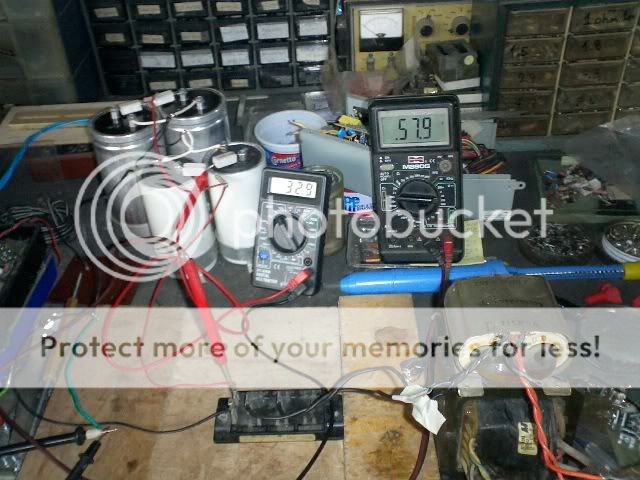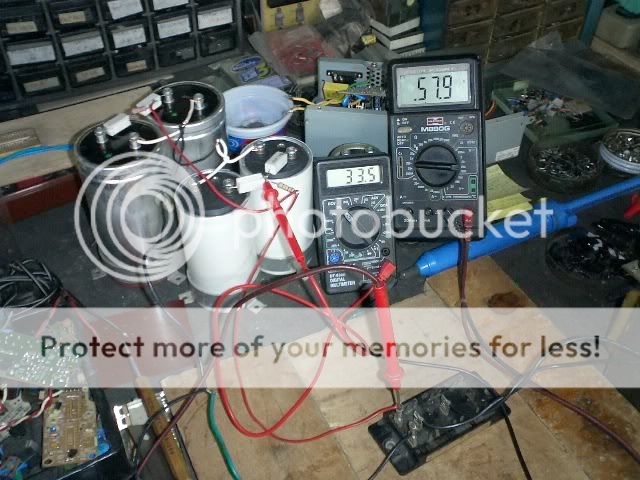Quote:
Check the date code on those before using! Lots of surplus CG types are around that are 20 years old or more, not a good thing.
Is it possible to reform these older caps or is this just myth? I have never done it so I cannot comment on the percentage of success or failure.
Check the date code on those before using! Lots of surplus CG types are around that are 20 years old or more, not a good thing.
Is it possible to reform these older caps or is this just myth? I have never done it so I cannot comment on the percentage of success or failure.
Any large cap should be reformed before using. Problem with these older ones is that even after reforming, there can be quite a bit of leakage current (that means heat!). And the capacitance may have greatly deteriorated over the years from loss of the electrolyte; reforming will not help this.
It's kindest to gently form any large capacitor regardless of age before serious use. All you need is a variable power supply, a DVM with a mA range, and a 1k resistor (to limit current). Connect them all in series with the capacitor and gently increase the current from zero whilst ensuring that it doesn't rise above 5mA. With a large capacitor, it can take some time to reach the capacitor's full rated voltage. Leave it at full voltage, and the leakage current will gently fall. Most capacitor data sheets give an expected leakage current (Rubycon quote the smaller of 0.02CV or 3mA).
But if all the electrolyte has evaporated, then it won't make any difference what you do...
But if all the electrolyte has evaporated, then it won't make any difference what you do...
I have a few 2400 uF 450 volt beer cans that I got on E-bay. Reforming is simple if you have a variable power supply. Hook the cap up to the power supply, set it at about 50 volts, and leave it for an hour or so. After that turn the voltage up 50 volts and wait about 15 minutes. Each 15 minutes raise the voltage 50 volts until 400 or so is reached. KEEP AN EYE ON THE CURRENT METER. It is normal for the cap to draw current as the voltage is raised. The current should drop to a few mA or less after a few seconds. Any cap that draws continuous current or gets warm should be discarded.
----------SAFETY WARNING---------
As explained before there is a lot of energy storage available here. This is of value in some amp designs. It is VERY DANGEROUS if abused. I would put the cap inside a heavy cardboard box during the reforming process. A cap that suddenly shorts internally can violently explode, or spew its electrolyte through the vent. Discard any leaky caps (those that get warm or draw current), these are prone to sudden failure. The electrical energy stored within can cause a serious shock, and WILL vaporize a small screwdriver if shorted out. The current pulse generated by shorting out one of these will usually cause damage to the cap, and any thing else in the path. BE CAREFUL. Discharge these through a large resistor, and verify that there is no residual voltage (with a voltmeter) before handling them.
Now what can you do with these. They are useful as a "stiffening cap" across the power supply in a class AB power amp. These make a noticible improvement in the bass and transient response in some amps. The initial charging current is outrageous and the power supply must be able to supply it without damage. I had one of them in my 300Beast amplifier. the charging current was limited by using an "inrush current limiter" in the transformer primary. The large cap actually slowed the turn on of the entire amplifier by several seconds. I have since removed the beer can and replaced it with a 470uF 450volt PC board cap with similar results. Size was the reason.
I plan to use the caps in a series (with equalizing resistors) connection for the filter in a high voltage power supply for my 833A amp. They would be useful in the power supply of an OTL amplifier (as suggested) because the peak currents here are in the multi amp range.
These caps usually have lots of internal inductance and therefore exhibit lousy behavior in the upper audio range. For best performance they should be bypassed with a good cap. I use surplus oil caps, or Solen fast caps (or both).
----------SAFETY WARNING---------
As explained before there is a lot of energy storage available here. This is of value in some amp designs. It is VERY DANGEROUS if abused. I would put the cap inside a heavy cardboard box during the reforming process. A cap that suddenly shorts internally can violently explode, or spew its electrolyte through the vent. Discard any leaky caps (those that get warm or draw current), these are prone to sudden failure. The electrical energy stored within can cause a serious shock, and WILL vaporize a small screwdriver if shorted out. The current pulse generated by shorting out one of these will usually cause damage to the cap, and any thing else in the path. BE CAREFUL. Discharge these through a large resistor, and verify that there is no residual voltage (with a voltmeter) before handling them.
Now what can you do with these. They are useful as a "stiffening cap" across the power supply in a class AB power amp. These make a noticible improvement in the bass and transient response in some amps. The initial charging current is outrageous and the power supply must be able to supply it without damage. I had one of them in my 300Beast amplifier. the charging current was limited by using an "inrush current limiter" in the transformer primary. The large cap actually slowed the turn on of the entire amplifier by several seconds. I have since removed the beer can and replaced it with a 470uF 450volt PC board cap with similar results. Size was the reason.
I plan to use the caps in a series (with equalizing resistors) connection for the filter in a high voltage power supply for my 833A amp. They would be useful in the power supply of an OTL amplifier (as suggested) because the peak currents here are in the multi amp range.
These caps usually have lots of internal inductance and therefore exhibit lousy behavior in the upper audio range. For best performance they should be bypassed with a good cap. I use surplus oil caps, or Solen fast caps (or both).
The caps are 3 months old. I have a friend who likes to experiment with high voltage combined with high current (coin shrinking) who ordered a case, as it was the cheapest way to get the amount he wanted, and he gave me the 4 extras (nice friend).
Currently the leakage current is under the 5 ma rating from the manufacturer.
I'm planning on making a pair of PPP EL34 amps so I can finally use some of my stash of tubes I've built up over the years.
I guess I'll go with some smaller ones, and save myself some headaches.
Currently the leakage current is under the 5 ma rating from the manufacturer.
I'm planning on making a pair of PPP EL34 amps so I can finally use some of my stash of tubes I've built up over the years.
I guess I'll go with some smaller ones, and save myself some headaches.
Please reform caps with a current limiting resistor, then the voltage increase is automatic and the chances of venting or "explosion" are nearly gone. This is what the manufactures recommend. Also note that you should reform to the surge voltage not just the rated voltage.
There is some interesting information on reforming electrolytic caps at the end of this page:
http://www.duracap.com/electrolytic_capacitors/application_guide.htm
There is some interesting information on reforming electrolytic caps at the end of this page:
http://www.duracap.com/electrolytic_capacitors/application_guide.htm
- Status
- This old topic is closed. If you want to reopen this topic, contact a moderator using the "Report Post" button.
- Home
- Amplifiers
- Tubes / Valves
- Computer Grade Capacitors


